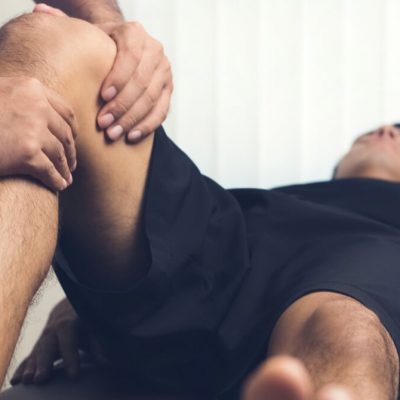The knee joint allows you to run, walk and play sport. Awkward movements, falls and collisions, sudden twists, excessive force or overuse can result in a range of injuries to the knee joint and the structures supporting it. Common knee injuries include ligament, tendon and cartilage tears, and patello-femoral pain syndrome.
Prompt medical attention for any knee injury increases the chances of a full recovery. Treatment options include physiotherapy, arthroscopic surgery and open surgery.
The structure of the knee
The knee is a hinge joint, situated between the thigh bone (femur) and shin bones (tibia and fibula). Contraction of the muscles on the front of the thigh (quadriceps) straightens the leg, while contraction of the muscles on the back of the thigh (the hamstrings) allows the leg to bend at the knee. The end of the femur rests in the shallow cup of the tibia, cushioned by a thick layer of cartilage.
At the front of the knee joint, the kneecap or patella sits in a groove at the lower end of the femur. The joint is further bolstered on each side by additional cartilages, which sit in between the knee joint. The bones are held in place by tough bands of connective tissue called ligaments. The entire joint is enclosed inside a tough capsule lined with a membrane and filled with lubricating synovial fluid. Extra capsules of fluid, known as bursae, offer extra cushioning.
Ligament sprains
The knee joint is held together by tough bands of connective tissue called ligaments. Sudden twists or excessive force on the knee joint, commonly caused by repeated jumping or coming to a rapid halt while running, can stretch ligaments beyond their capacity. Torn ligaments can bleed into the knee and typically cause swelling, pain and joint laxity. The anterior cruciate ligament (ACL) situated in the centre of the joint is the knee ligament commonly injured. A ruptured ACL does not heal by itself and may require reconstructive surgery.
Tendon tears
The muscles are anchored to the joints with tendons. Overstretched tendons can tear and bleed, but these injuries tend to heal by themselves without the need for surgery.
Cartilage tears
The knee joint is bolstered on both sides by additional strips of cartilage, called ‘menisci’ or semilunar cartilages. One of the most common knee injuries is a torn or split meniscus. Severe impact or twisting, especially during weight bearing exercise, can tear this cartilage. Tears of the meniscus can also occur in older people due to wear and tear. Symptoms include swelling, pain and the inability to straighten the leg. The damaged cartilage can be surgically trimmed or even removed without causing any joint instability.
Patello-femoral pain syndrome
Patello-femoral pain syndrome is characterised by pain felt behind the kneecap. Squatting, walking up and down hills or stairs, or sitting still for extended periods of time can exacerbate the pain. The usual cause is abnormal movement of the kneecap as the knee is bent and straightened. This can lead to wear and tear of the cartilage on the back of the kneecap. Imbalances in muscle strength, tight muscles and structural abnormalities of the lower limb can contribute to the problem. The pain usually comes on gradually over time.
First aid for knee injuries in the first 48 to 72 hours
Suggestions for first aid treatment of an injured knee include:
- Stop your activity immediately. Don’t ‘work through’ the pain.
- Rest the joint at first.
- Reduce pain, swelling and internal bleeding with icepacks, applied for 15 minutes every couple of hours.
- Bandage the knee firmly and extend the wrapping down the lower leg.
- Elevate the injured leg.
- Don’t apply heat to the joint.
- Avoid alcohol, as this encourages bleeding and swelling.
- Don’t massage the joint, as this encourages bleeding and swelling.
Professional help for knee injuries
Mild knee injuries may heal by themselves, but all injuries should be checked and diagnosed by a doctor or physiotherapist. Persistent knee pain needs professional help. Prompt medical attention for any knee injury increases the chances of a full recovery.
Treatment options include:
- Physiotherapy – including ultrasound and electrical muscle stimulation treatment, kneecap taping, exercises for increased mobility and strength, and associated rehabilitation techniques.
- Aspiration – if the knee joint is grossly swollen, the doctor may release the pressure by drawing off some of the fluid with a fine needle.
- Arthroscopic surgery – or ‘keyhole’ surgery, where the knee operation is performed by inserting slender instruments through small incisions (cuts). Cartilage tears are often treated with arthroscopic surgery.
- Open surgery – required when the injuries are more severe and the entire joint needs to be laid open for repair.
Prevention tips for knee injuries
You can help to prevent injuries if you:
- Warm-up joints and muscles by gently going through the motions of your sport or activity and stretching muscles.
- Wear appropriate footwear.
- Avoid sudden jarring motions.
- Try to turn on the balls of your feet when you’re changing direction, rather than twisting through your knees.
- Cool down after exercise by performing light, easy and sustained stretches
- Build up an exercise program slowly over time.
Where to get help
- Your doctor
- Physiotherapist
- Sports physician
Things to remember
- Common knee injuries include ligament, tendon and cartilage tears, and patello-femoral pain syndrome.
- Prompt medical attention for any knee injury increases the chances of a full recovery.
- Treatment options include physiotherapy, arthroscopic surgery and open surgery.
If you would like to speak to one of our Physiotherapists about your knee pain, please give us a call on (03) 9873 3333.
(Disclaimer: The above information has been adapted from the Better Health Channel website 2013).



